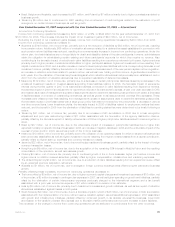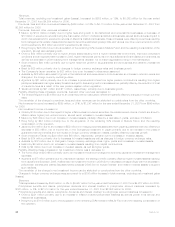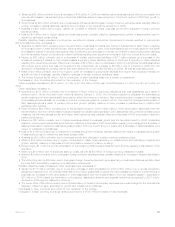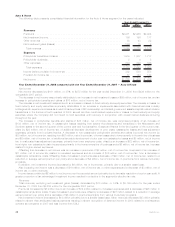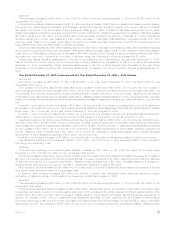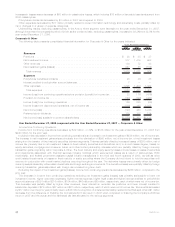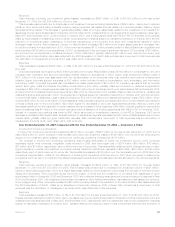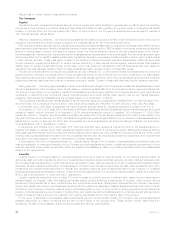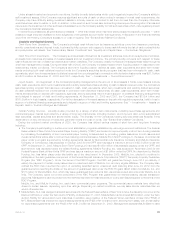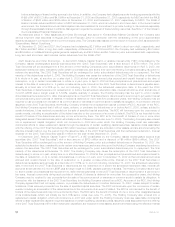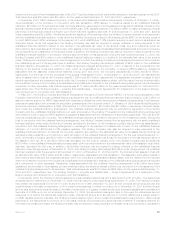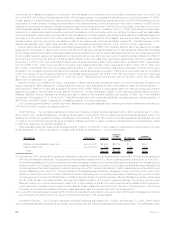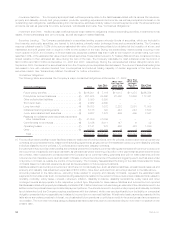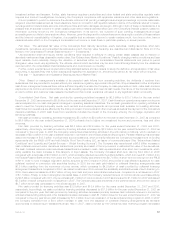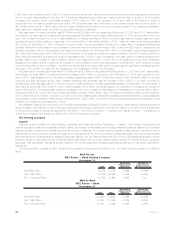MetLife 2008 Annual Report Download - page 51
Download and view the complete annual report
Please find page 51 of the 2008 MetLife annual report below. You can navigate through the pages in the report by either clicking on the pages listed below, or by using the keyword search tool below to find specific information within the annual report.MetLife has no current plans to raise additional capital.
The Company
Capital
Capital and liquidity represent the financial strength of the Company and reflect its ability to generate strong cash flows at the operating
companies, borrow funds at competitive rates and raise additional capital to meet operating and growth needs. To strengthen its capital
position, in October 2008, the Company issued $2.3 billion of common stock. The Company’s capital structure is managed to maintain a
“AA” financial strength ratings target.
Statutory Capital and Dividends. Our insurance subsidiaries have statutory surplus and RBC levels well above levels to meet current
regulatory requirements and levels needed to support the business risk at an “AA” financial strength rating.
RBC requirements are used as minimum capital requirements by the National Association of Insurance Commissioners (“NAIC”) and the
state insurance departments to identify companies that merit further regulatory action. RBC is based on a formula calculated by applying
factors to various asset, premium and statutory reserve items. The formula takes into account the risk characteristics of the insurer,
including asset risk, insurance risk, interest rate risk and business risk and is calculated on an annual basis. The formula is used as an early
warning regulatory tool to identify possible inadequately capitalized insurers for purposes of initiating regulatory action, and not as a means
to rank insurers generally. These rules apply to each of the Holding Company’s domestic insurance subsidiaries. State insurance laws
provide insurance regulators the authority to require various actions by, or take various actions against, insurers whose total adjusted
capital does not exceed certain RBC levels. At the date of the most recent annual statutory financial statements filed with insurance
regulators, the total adjusted capital of each of these subsidiaries was in excess of each of those RBC levels.
The amount of dividends that our insurance subsidiaries can pay to MetLife, Inc. or other parent entities is constrained by the amount of
surplus we hold to maintain our ratings, and to provide an additional margin for risk protection and for future investment in our businesses.
We proactively take actions to maintain capital consistent with these ratings objectives, which may include adjusting dividend amounts and
redeploying financial resources from internal or external sources of capital. Certain of these activities may require regulatory approval.
Rating Agencies. The rating agencies assign insurer financial strength ratings to the Company’s domestic life subsidiaries and credit
ratings to subsidiaries of the Company which directly issue or guarantee substantially all of the Company’s senior unsecured obligations.
The level and composition of our regulatory capital at the subsidiary level and equity capital of the Company are among the many factors
considered in determining the Company’s insurer financial strength and credit ratings. Each agency has its own capital adequacy
evaluation methodology and assessments are generally based on a combination of factors.
The Company’s financial strength ratings targets for its domestic life insurance companies are “AA/Aa2/AA/A+” for S&P, Moody’s, Fitch,
and A.M. Best. The Company’s long-term senior debt credit rating targets are “A/A2/A/a” for S&P, Moody’s, Fitch, and A.M. Best.
In November 2008, A.M. Best downgraded the insurer financial strength rating for Texas Life Insurance Company from A to A-.
At December 31, 2008, A.M. Best, Fitch, Moody’s and S&P each had MetLife and its Subsidiaries’ insurer financial strength and credit
ratings on “stable” outlook; however, (i) on February 9, 2009, Moody’s revised its outlook to “negative,” (ii) on February 11, 2009, Fitch
revised its outlook to “negative” and anticipates completing its review within the next several weeks and will reflect those results in the
ratings at that time, (iii) on February 20, 2009, A.M. Best downgraded the credit ratings of MetLife, Inc. and certain of its subsidiaries with a
stable outlook, and (iv) on February 26, 2009, S&P downgraded the insurer financial strength and credit ratings of MetLife, Inc. and certain
of its subsidiaries, with a “substantive” outlook.
In September and October 2008, A.M. Best, Fitch, Moody’s, and S&P each revised its outlook for the U.S. life insurance sector to
negative from stable. In January 2009, S&P reiterated its negative outlook on the U.S. life insurance sector. Management believes that the
rating agencies may heighten the level of scrutiny that they apply to such institutions, may increase the frequency and scope of their credit
reviews, may request additional information from the companies that they rate, and may adjust upward the capital and other requirements
employed in the rating agency models for maintenance of certain ratings levels.
A downgrade in the credit or financial strength (i.e., claims-paying) ratings of the Company or its subsidiaries would likely impact the
cost and availability of unsecured financing for the Company and its subsidiaries and result in additional collateral requirements or other
required payments under certain agreements, which are eligible to be satisfied in cash or by posting securities held by the subsidiaries
subject to the agreements.
Liquidity
Liquidity refers to a company’s ability to generate adequate amounts of cash to meet its needs. The Company’s liquidity position is
defined as cash and cash equivalents, short-term investments and publicly-traded securities excluding (i) cash collateral received under
the Company’s securities lending program that has been reinvested in cash, cash equivalents, short-term investments and publicly-traded
securities; (ii) cash collateral received from counterparties in connection with derivative instruments; (iii) cash, cash equivalents, short-term
investments and publicly-traded securities on deposit with regulatory agencies; and (iv) securities held-in-trust in support of collateral
financing arrangements and pledged in support of debt and funding agreements. The Company’s liquidity position was $139.4 billion and
$163.8 billion at December 31, 2008 and 2007, respectively.
Liquidity needs are determined from a rolling 12-month forecast by portfolio and are monitored daily. Asset mix and maturities are
adjusted based on forecast. Cash flow testing and stress testing provide additional perspectives on liquidity, which include various
scenarios of the potential risk of early contractholder and policyholder withdrawal. Management believes that the Company has ample
liquidity and capital resources to meet business requirements and unlikely but reasonably possible stress scenarios under current market
conditions. The Company includes provisions limiting withdrawal rights on many of its products, including general account institutional
pension products (generally group annuities, including GICs, and certain deposit fund liabilities) sold to employee benefit plan sponsors.
Certain of these provisions prevent the customer from making withdrawals prior to the maturity date of the product.
In the event of significant unanticipated cash requirements beyond normal liquidity needs, the Company has various alternatives
available depending on market conditions and the amount and timing of the liquidity need. These options include cash flows from
operations, the sale of liquid assets, global funding sources and various credit facilities.
48 MetLife, Inc.



